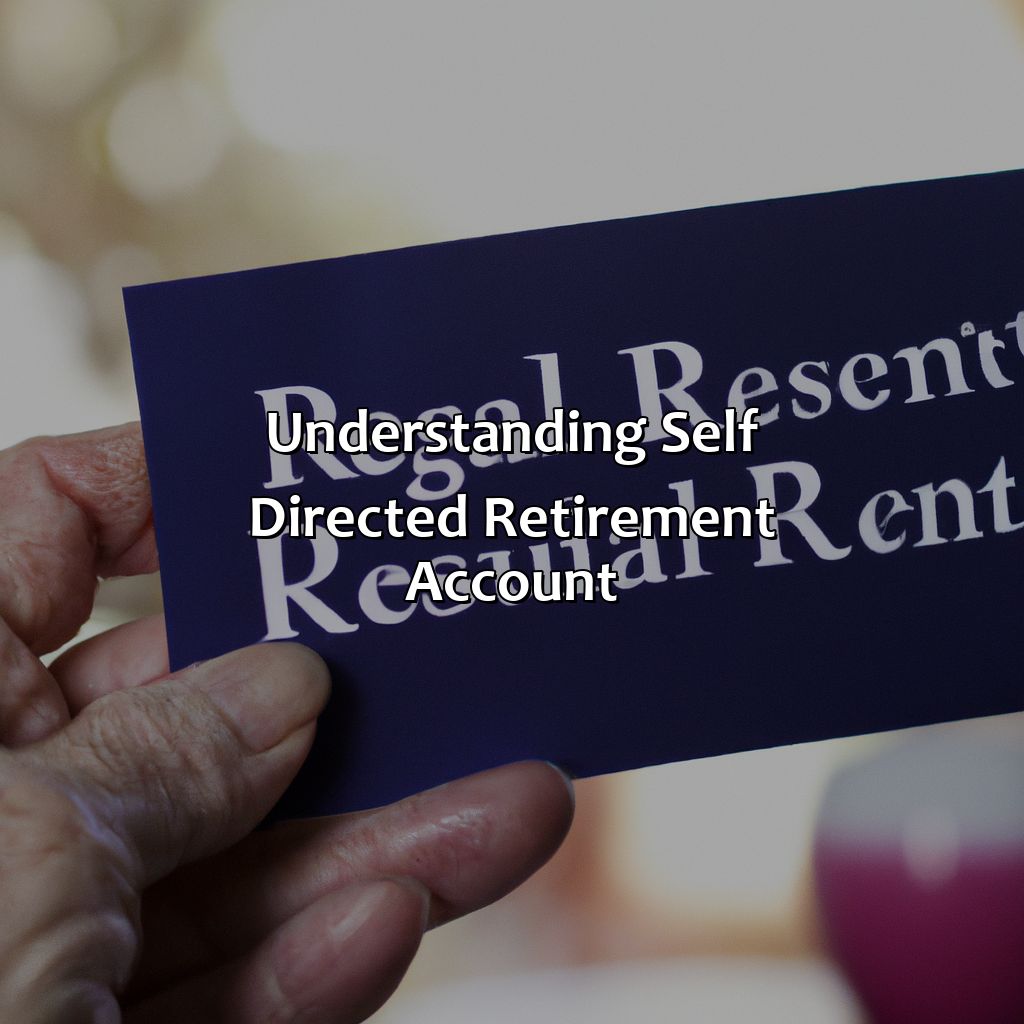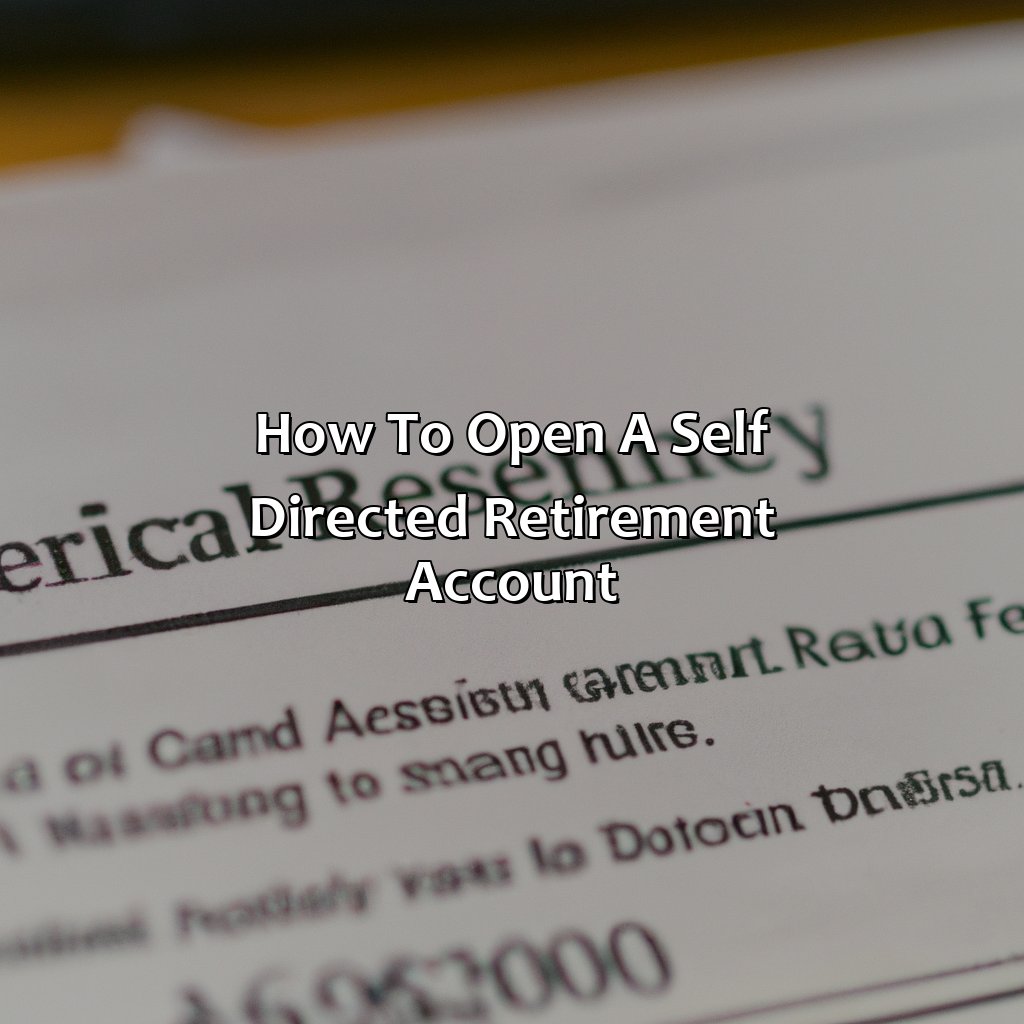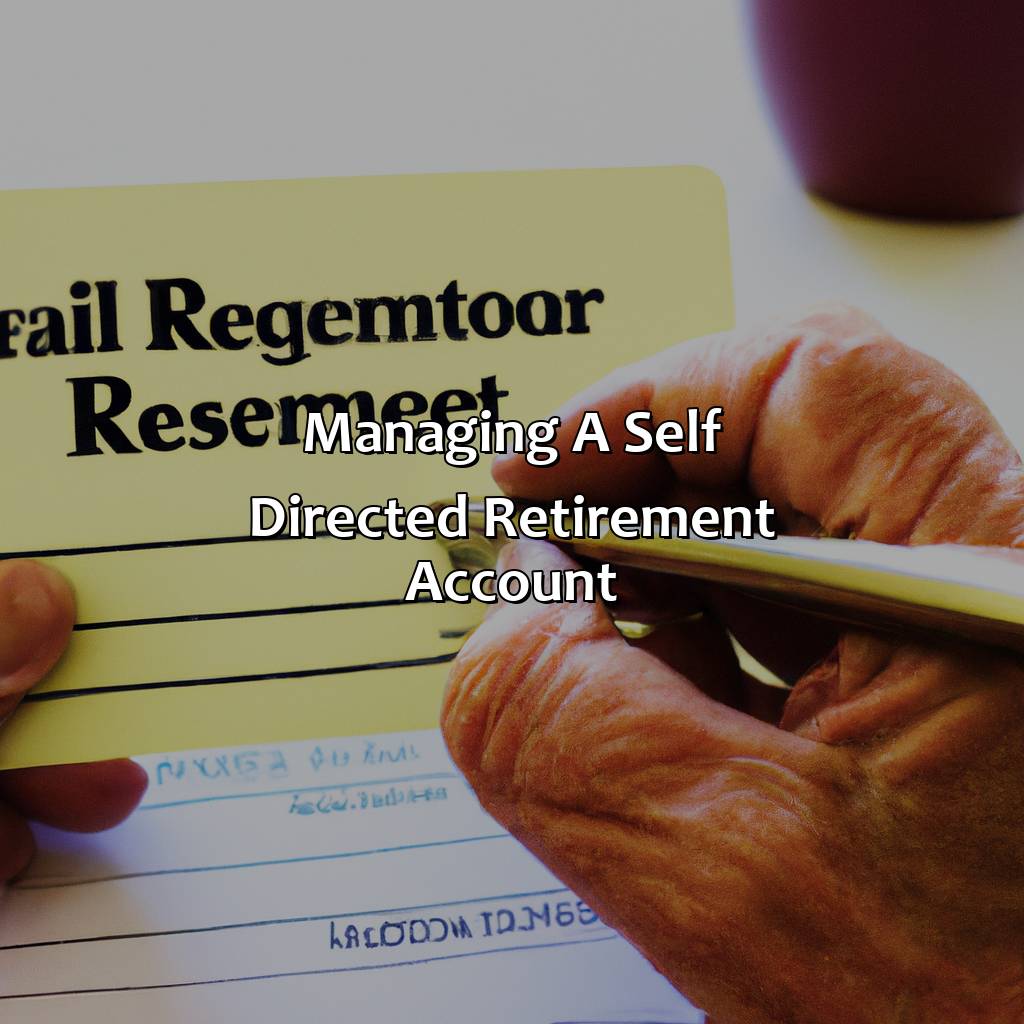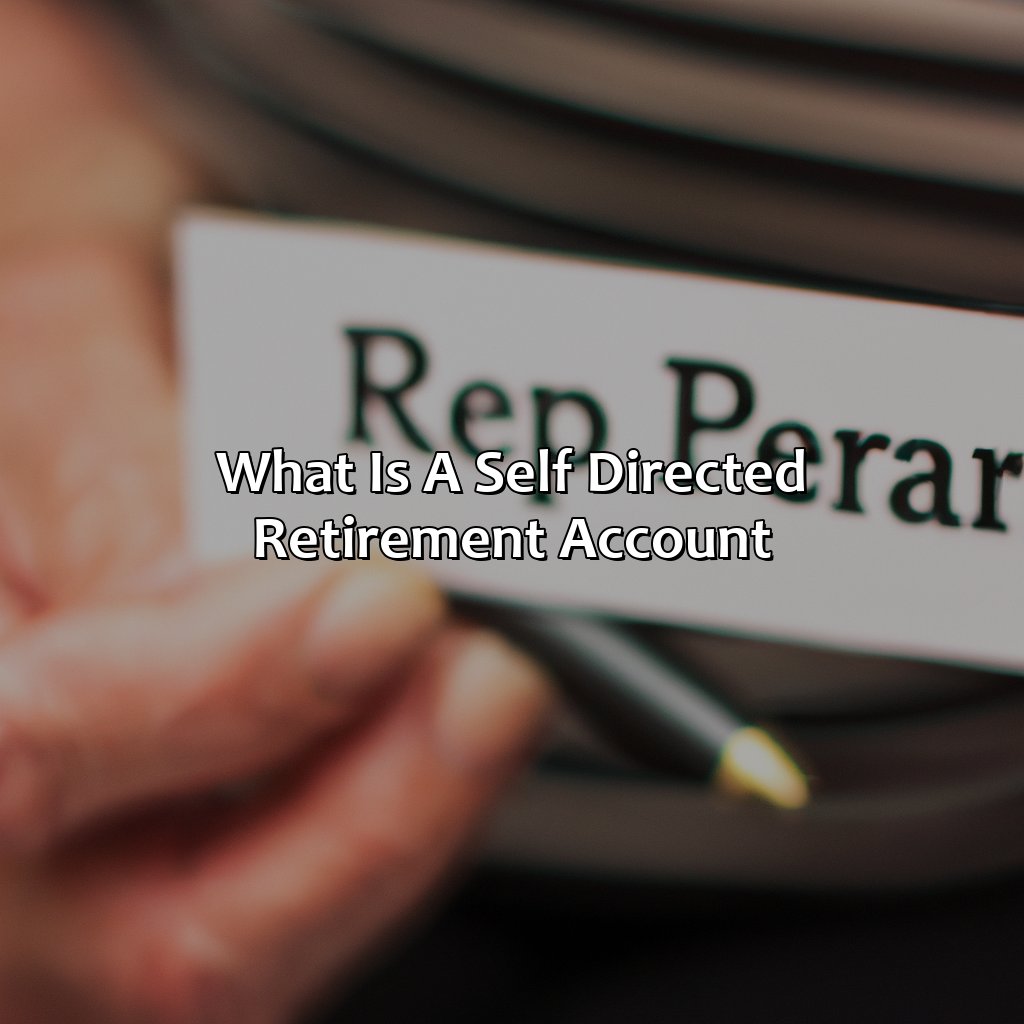What Is A Self Directed Retirement Account?
Key Takeaway:
- A self directed retirement account is a type of retirement account that gives individuals more control over their investments, allowing them to invest in a wider range of assets beyond traditional stocks and bonds.
- There are various types of self directed retirement accounts, such as self directed IRAs, solo 401(k)s, and health savings accounts, each with their own eligibility criteria and investment options.
- The benefits of a self directed retirement account include potential higher returns, tax advantages, and flexibility in investment choices. However, it is important to understand the rules and regulations, as well as the risks and responsibilities that come with managing a self directed retirement account.
You deserve to have control of your retirement account and know what it means. A self-directed retirement account allows you to make decisions about your investments and financial future to ensure you have a secure retirement. Learn what a self-directed retirement account is and how it can help you.
Understanding Self Directed Retirement Account
Do you need a comprehensive idea about self-directed retirement accounts? This type of flexible investment option gives you control over your retirement savings. Various types exist, each with distinct features and benefits. Knowing the definition and types of self-directed retirement accounts can help you gain more control over your retirement savings and financial future.

Image credits: retiregenz.com by Yuval Washington
Definition of Self Directed Retirement Account
A self-directed retirement account is a type of managed account that provides investment options beyond stocks and bonds. It offers the investor independence in their investment decisions, giving them the freedom to choose from alternative investments like real estate, private equity, and precious metals. Unlike traditional retirement accounts, self-directed accounts operate under different rules and regulations.
Self-directed retirement accounts often require investors to have specialized knowledge about alternative investments or to work with professionals who can help them make informed decisions about their investments. Investors must also abide by certain IRS regulations when investing in alternative assets using these types of accounts.
It’s important for investors to carefully research the risks involved and fully understand the rules and restrictions of self-directed retirement accounts before deciding whether to invest.
Investors seeking greater control over their retirement savings should consider opening a self-directed retirement account. This requires due diligence in researching investment opportunities and partnering with trusted professionals with specialized knowledge in areas such as real estate or private equity. With proper guidance, investors can utilize this option to diversify their portfolio and potentially achieve greater returns for their future wellbeing.
Get ready to be the master of your retirement domain with these types of self-directed retirement accounts.
Types of Self Directed Retirement Account
Self-directed retirement accounts come in different types. These types offer various investment options that suit different investors. Below is a list of the types of self-directed retirement accounts with their unique features.
| Type of Account | Features |
| Traditional IRA | Tax-deductible contributions, penalty for early withdrawals, mandatory distributions once you turn 70 and a half. |
| Roth IRA | Tax-free withdrawals during retirement age, but no tax deductions on contributions. |
| Solo-401(k) | Permits employees to make regular salary deferrals and provides an additional option for employers to contribute. |
Moreover, depending on your financial needs and goals, there are other self-directed retirement accounts like SEP-IRAs, SIMPLE IRAs and Individual (k) plans. It’s advisable to seek professional advice when choosing the best account that suits your investment profile.
Don’t miss out on the opportunity to secure your financial future by exploring self-directed retirement accounts today. Contact a financial advisor or investment expert who can walk you through the process of creating your account.
Why settle for a normal retirement account when you can be in control with a self directed one? It’s like upgrading from a tricycle to a Ferrari.
Benefits of a Self Directed Retirement Account
A self directed retirement plan offers a gamut of benefits in terms of control, diversification and investment options. These plans provide an opportunity for investors to customize their portfolios and invest beyond stocks, bonds and mutual funds.
- Flexible Investment Options: With a self directed account, you can invest in alternative assets such as real estate, precious metals and private equity. This allows investors to diversify their portfolio while accessing potentially higher returns.
- Tax Benefits: Investing in non-traditional assets can yield various tax advantages such as deferral or exemption from taxes on income and capital gains. Self-directed retirement accounts also offer more control over taxes compared to traditional plans.
- Other Financial Advantages: By investing in alternative options not available through traditional retirement vehicles, individuals have the opportunity to increase overall returns within their portfolio. Additionally, certain types of self directed accounts may be rolled over or transferred into other investment vehicles tax-free.
Further, it’s important to note that rules concerning self directed retirement accounts are set by the Internal Revenue Service (IRS) and therefore investors have to ensure they comply with these regulations.
Ready to be your own retirement boss? Here’s how to open a self directed retirement account and start living life on your own terms.
How to Open a Self Directed Retirement Account
Are you eligible to open a self-directed retirement account? Worry not! We got you covered. We’ll show you the steps to open one. Plus, all the investment options, and other details. Everything from the beginning to the end – no details missed!
- Make sure you qualify (i.e. you have earned income) to contribute to a retirement account.
- Choose a self-directed IRA provider and complete their application process.
- Make your contribution for the year (up to the contribution limit).
- Select your investments according to your goals and risk tolerance.
- Monitor your account regularly for any necessary adjustments.

Image credits: retiregenz.com by Joel Duncun
Eligibility Criteria
To be eligible to open a self-directed retirement account, one must meet certain criteria. These include:
- having earned income,
- being under the age of 70.5 years old,
- and not being enrolled in an employer-sponsored retirement plan.
- Additionally, one must also have an account with a qualified custodian who can facilitate self-directed investments.
Once eligibility requirements are met, opening a self-directed retirement account requires some groundwork. One must first choose a custodian who specializes in offering these types of accounts and fill out the necessary paperwork to establish the account. Funding the account typically involves rolling over funds from an existing IRA or transferring funds from another type of savings or investment account.
It’s essential to note that there are limitations on the types of investments allowed within a self-directed retirement account, including restrictions on investing in collectibles or life insurance. Additionally, it’s crucial to conduct thorough research and consult with financial advisors before making any investment decisions.
To ensure successful management of a self-directed retirement account, consider regularly reviewing and re-evaluating investment strategies. It’s essential to stay up-to-date on market trends and seek professional guidance when necessary. By taking these steps, individuals can maximize their potential returns while minimizing risks associated with unguided investments.
Finally, a way to take control of your retirement without having to rely on your grandkids for support.
Steps to Open a Self Directed Retirement Account
Self-directed retirement accounts offer investors greater flexibility and control over their savings. Here’s how to set one up:
- Choose a custodian: Look for a custodian that allows self-directed investments, such as real estate or private equity holdings.
- Complete the paperwork: Fill out the necessary forms provided by your chosen custodian. Be sure to provide accurate information and follow all instructions carefully.
- Fund your account: Once the paperwork is complete, transfer funds from an existing IRA or 401(k) into your new self-directed account.
- Invest wisely: With a self-directed retirement account, you have more investment options than with traditional accounts. However, it’s important to do your due diligence before investing in any assets.
It’s important to understand that self-directed retirement accounts carry higher risk potential than traditional accounts. Consider consulting with a financial advisor before opening one.
When investing in alternative assets like real estate or private equity through a self-directed retirement account, you must ensure compliance with IRS regulations regarding prohibited transactions and disqualified persons.
A true story of someone who opened a self-directed retirement account might go something like this: John was frustrated with limited investment options offered by his traditional IRA. He decided to open a self-directed IRA and invested in a rental property that generated significant returns for his retirement savings.
If investing in the stock market is too mainstream for you, consider investing in rare Pez dispensers or Beanie Babies – because who needs a diversified portfolio?
Investment Options
As an investor, having a plethora of investment options can be overwhelmingly beneficial. Self-managed retirement accounts offer such options to investors who want to have more control over their portfolio than traditional retirement accounts provide.
With a self-directed retirement account, investors can invest in various alternative assets like private equity, real estate, and even cryptocurrencies. The flexibility of these investment options makes it an attractive choice for long-term wealth building.
However, investors should be aware that these investment options also come with risks, as alternative investments aren’t regulated by the SEC like traditional stocks and bonds are.
Investors who are well-versed in these alternative investments may find a self-directed retirement account to be an advantageous way to leverage their knowledge for long-term profits. It’s important to understand the risks and consult with professionals before jumping into this type of account. Don’t miss out on the lucrative opportunities available through self-directed retirement accounts.
Managing your retirement account is like playing chess – if you don’t think ahead, you’ll end up in checkmate.
Managing a Self Directed Retirement Account
You gotta understand the rules and regulations, risks, and responsibilities of managing your own retirement account.
To maximize benefits, check out these tips. In the sections ahead, we’ll deep-dive into all the details!

Image credits: retiregenz.com by Yuval Washington
Rules and Regulations
Managing a Self Directed Retirement Account – Governing Principles
A self-directed retirement account is governed by strict principles and regulations established by the IRS. These rules protect your retirement account from penalties and taxes, as well as guide you on the type of assets that can be invested in.
To comply with these governing principles, it is important to conduct due diligence before investing in any asset. This includes researching investment options thoroughly and avoiding prohibited transactions such as using the account to buy personal property.
Furthermore, rules and regulations may change over time. Thus, it is essential to keep up-to-date with IRS regulations or seek professional advice to ensure compliance for the long-term success of your retirement plan.
According to Forbes, over 50 million Americans have a self-directed retirement plan.
Managing a self-directed retirement account is like playing hot potato with your money, except the potato is on fire and you’re blindfolded.
Risks and Responsibilities
A Self Directed Retirement Account requires a thorough understanding of the risks and responsibilities associated with it. Investors bear full responsibility for due diligence, investment selection, and tax compliance. With great freedom comes great responsibility.
Investors should manage their account prudently to avoid potential pitfalls such as fraud, prohibited transactions, and disqualified persons. Being fully aware of the risks involves selecting trustworthy service providers and consulting trusted advisors who understand the intricacies of self-directed investment. Due to the lack of SIPC insurance and limited regulatory oversight, investors must assume full liability for any losses incurred.
It’s imperative to keep record-keeping up-to-date to prove compliance with IRS requirements and avoid penalties. Transactions must be documented properly to meet reporting obligations, which could incur adverse consequences. Although SDIRAs provide greater flexibility in investments than more traditional retirement accounts, they also necessitate a higher level of engagement from investors.
To stay fully informed about regulations and requirements related to SDIRAs, investors must stay up-to-date with new developments or changes in laws that impact them. The Securities and Exchange Commission (SEC), Internal Revenue Service (IRS), Department of Labor (DOL), and state securities administrators are all valuable sources of information on existing rules/regulations.
In 2018’s case involving CKR Law’s partner starstruck by A-list celebrities such as Rihanna or LeBron James invested $50k but end up burning nearly $25 million worth in fraudulent deals as COVID-19 spreads will lead many people to lose their life savings through bad investing decisions i.e., being unaware of the prevailing market risk factors is one such vital lesson learned regarding SRDAs.
For the ultimate retirement plan, invest in a self directed account and start living your golden years like a boss.
Tips to Maximize Benefits
A self-directed retirement account can be an excellent resource for long-term financial stability. Here are some tips on how to get the most out of it:
- Do your research- before investing in any asset class, thoroughly analyze its potential returns and risks.
- Diversify your portfolio- spread your investments over a range of assets to mitigate risk and maximize rewards
- Stay up to date with regulations- being aware of changes in tax laws, contribution limits, and other regulations can help you make informed decisions.
- Consult with a financial advisor- working with an experienced professional can be especially helpful in navigating complex investment strategies and avoiding costly mistakes.
It’s also worth noting that while self-directed retirement accounts offer greater flexibility than conventional IRA or 401k plans, they require more active participation from the account holder. Keeping up with market trends, asset performance, and regulatory changes is crucial for optimal results.
The Importance of Educating Yourself
One often overlooked aspect of managing a self-directed retirement account is the importance of education. With so many different investment options available, it’s essential to understand the advantages and disadvantages of each one before committing significant funds.
A Real-Life Example
Recently, a middle-aged man invested his entire retirement savings into cryptocurrency within his self-directed IRA. Hailed as revolutionary by some investors but referred to as poorly understood by others, crypto assets are widely perceived as high-risk propositions but have surged in popularity despite not being insured or regulated by the Federal Deposit Insurance Corporation (FDIC) or any other government agency. After going through wild price swings culminating in a series of crashes that saw bitcoin’s value fall by more than half in just two months from April 2021. The investor missed his chance to retire comfortably as he lost tens of thousands of dollars in a few months due to poor research and education before investing. Therefore, this further highlights the importance of proper education before delving into investments to maximize returns.
Some Facts About Self Directed Retirement Accounts:
A self directed retirement account allows an individual to have more control over their investment choices. (Source: Investopedia)
With a self directed retirement account, individuals can invest in alternative assets such as real estate, private equity, and precious metals. (Source: Forbes)
Self directed retirement accounts can offer tax advantages, but also come with higher fees and greater responsibility for the individual investor. (Source: The Balance)
Not all financial institutions offer self directed retirement accounts, so it is important to do research and shop around for the best options. (Source: US News & World Report)
Self directed retirement accounts can be a good option for experienced investors with a high risk tolerance and knowledge of alternative investment options. (Source: CNBC)
FAQs about What Is A Self Directed Retirement Account?
What is a self directed retirement account?
A self-directed retirement account is a specialized investment tool that allows investors to take control of their retirement savings. This type of account enables individuals to make their own investment decisions and potentially yield higher returns than traditional retirement accounts.
What types of accounts can be self directed?
Nearly all types of retirement accounts can be set up as self-directed, including Individual Retirement Accounts (IRAs), Solo 401(k)s, Traditional IRAs, Roth IRAs, SEP IRAs, and SIMPLE IRAs.
What are some of the benefits of using a self directed retirement account?
One significant benefit of using a self-directed retirement account is that it provides investors with greater control over their investment portfolio. This can result in potentially higher returns and a more diversified portfolio. Additionally, self-directed retirement accounts often offer greater flexibility and the ability to invest in alternative assets such as real estate, private equity, and precious metals.
What are some of the risks of using a self directed retirement account?
While self-directed retirement accounts can provide investors with greater flexibility and control, they also entail some risk. For instance, investing in alternative assets such as real estate or private equity can be riskier than traditional investments and can result in significant losses if the investments do not perform as expected. Additionally, investors must be knowledgeable and experienced in investing to effectively manage their self-directed retirement accounts.
What costs are associated with a self directed retirement account?
Like all retirement accounts, self-directed retirement accounts typically come with administrative and custodial fees. Additionally, because self-directed accounts allow investors to invest in a wider range of assets, investors may incur additional transaction and management fees.
How can I set up a self directed retirement account?
To set up a self-directed retirement account, you must first find a custodian that specializes in self-directed accounts. This custodian will manage your account, process transactions, and provide ongoing support. Once you have chosen a custodian, you can transfer funds from an existing retirement account or contribute new funds to your self-directed account. From there, you can select the investments you want to make and manage your account as desired.
 Checkout this IRS Loophole
Checkout this IRS Loophole 





